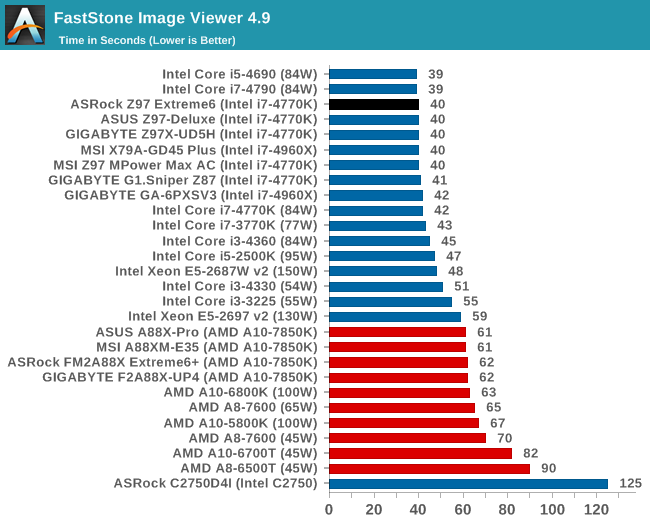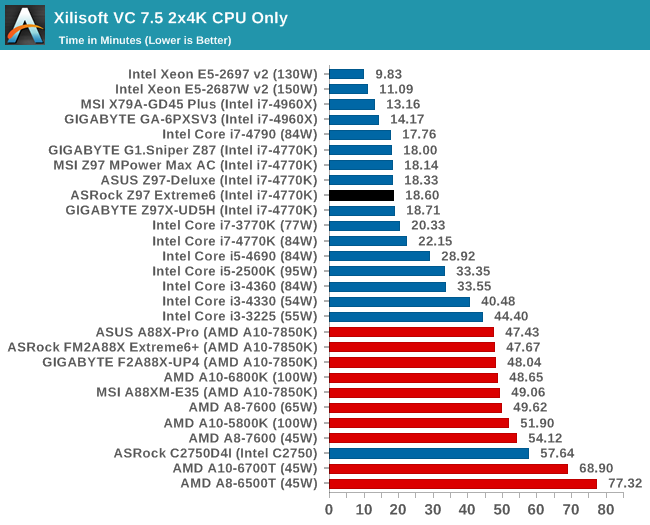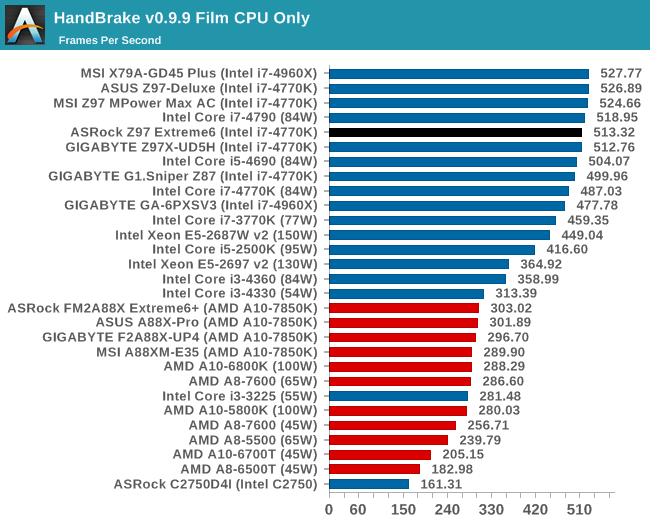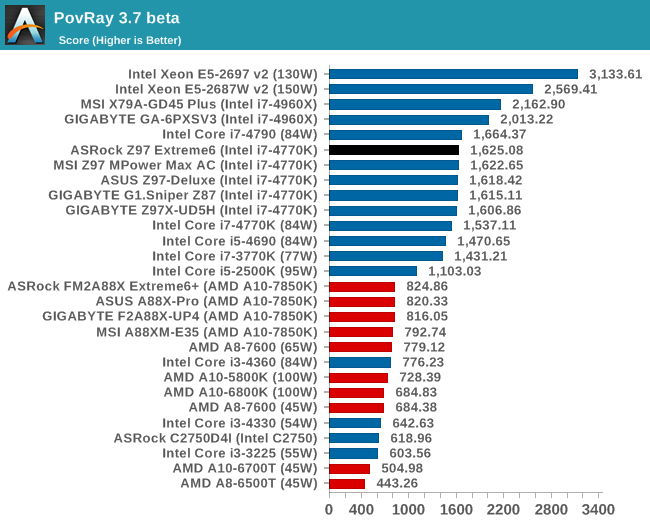ASRock Z97 Extreme6 Review: Ultra M.2 x4 Tested With XP941
by Ian Cutress on May 24, 2014 12:00 PM ESTReal World CPU Benchmarks
Readers of our motherboard review section will have noted the trend in modern motherboards to implement a form of MultiCore Enhancement / Acceleration / Turbo (read our report here) on their motherboards. This does several things – better benchmark results at stock settings (not entirely needed if overclocking is an end-user goal), at the expense of heat and temperature, but also gives in essence an automatic overclock which may be against what the user wants. Our testing methodology is ‘out-of-the-box’, with the latest public BIOS installed and XMP enabled, and thus subject to the whims of this feature. It is ultimately up to the motherboard manufacturer to take this risk – and manufacturers taking risks in the setup is something they do on every product (think C-state settings, USB priority, DPC Latency / monitoring priority, memory subtimings at JEDEC). Processor speed change is part of that risk which is clearly visible, and ultimately if no overclocking is planned, some motherboards will affect how fast that shiny new processor goes and can be an important factor in the purchase.
Compression – WinRAR 5.0.1: link
Our WinRAR test from 2013 is updated to the latest version of WinRAR at the start of 2014. We compress a set of 2867 files across 320 folders totaling 1.52 GB in size – 95% of these files are small typical website files, and the rest (90% of the size) are small 30 second 720p videos.

Image Manipulation – FastStone Image Viewer 4.9: link
Similarly to WinRAR, the FastStone test us updated for 2014 to the latest version. FastStone is the program I use to perform quick or bulk actions on images, such as resizing, adjusting for color and cropping. In our test we take a series of 170 images in various sizes and formats and convert them all into 640x480 .gif files, maintaining the aspect ratio. FastStone does not use multithreading for this test, and thus single threaded performance is often the winner.

Video Conversion – Xilisoft Video Converter 7: link
The XVC test I normally do is updated to the full version of the software, and this time a different test as well. Here we take two different videos: a double UHD (3840x4320) clip of 10 minutes and a 640x266 DVD rip of a 2h20 film and convert both to iPod suitable formats. The reasoning here is simple – when frames are small enough to fit into memory, the algorithm has more chance to apply work between threads and process the video quicker. Results shown are in seconds and time taken to encode.


Video Conversion – Handbrake v0.9.9: link
Handbrake is a media conversion tool that was initially designed to help DVD ISOs and Video CDs into more common video formats. The principle today is still the same, primarily as an output for H.264 + AAC/MP3 audio within an MKV container. In our test we use the same videos as in the Xilisoft test, and results are given in frames per second.


Rendering – PovRay 3.7: link
The Persistence of Vision RayTracer, or PovRay, is a freeware package for as the name suggests, ray tracing. It is a pure renderer, rather than modeling software, but the latest beta version contains a handy benchmark for stressing all processing threads on a platform. We have been using this test in motherboard reviews to test memory stability at various CPU speeds to good effect – if it passes the test, the IMC in the CPU is stable for a given CPU speed. As a CPU test, it runs for approximately 2-3 minutes on high end platforms.











43 Comments
View All Comments
Haravikk - Sunday, May 25, 2014 - link
Once again I can't understand this over-subscription that results in complex balancing of which SATA ports are used. I mean really, how many people buying these types of motherboards actually need more than four SATA ports? How many actually need a full seven PCIe slots? Just compromise on one or both, and reallocate the bandwidth; juggling ports that work and don't isn't something a builder should have to worry about, it should just be a case of plugging stuff in anywhere that fits and then starting it up.R3MF - Sunday, May 25, 2014 - link
Reducing GPU access to 8x PCIe 3.0 lanes wouldn't be a problem on Kaveri/FM2+ as they have 24x PCIe 3.0 from the APU.If only they'd release an X6 refresh of Kaveri...
TelstarTOS - Sunday, May 25, 2014 - link
"GIGABYTE originally had that issue with their Z87 1080p BIOS, but it is fixed for Z97."Gigabyte? ;)
Ian Cutress - Sunday, May 25, 2014 - link
Yup, GIGABYTE had the issue of having a full HD mode but it wasn't initiated by default, and they fixed it for Z97 such that I can boot into full HD mode directly. ASRock still required me to select the full HD mode from the 720p mode.isa - Sunday, May 25, 2014 - link
I'm pretty sure the z97 chipset supports m.2 with 4 channels of PCIe 2.0, but this article states most or all upcoming m.2 implementations will be limited to just 2 channels of PCIe 2.0. Do I have my facts straight, and if so, why the 2 channel limit? I can speculate as well as anyone and thus I'm not interested in speculation, but please comment if you actually know. thanks!isa - Sunday, May 25, 2014 - link
To be clearer, I'd hope m.2 cards and sockets for any laptop to have 4 channels, since overall bandwidth issues with lots of ports that affect desktops just isn't an issue.SirKnobsworth - Sunday, May 25, 2014 - link
I believe that the Z97 chipset only supports SSD caching on two lanes. Not that this matters all, or perhaps even most of the time, but maybe it was done just to avoid confusion.isa - Tuesday, May 27, 2014 - link
OK, I looked up the z97 chipset specs in Intel's site, and I believe the answer is that the chipset provides 8 total PCIe 2.0 channels, and these can be assigned in any combo of 1x, 2x or 4x channel bundles as long as the total is 8 or less. So the chipset supports assigning 4 channels to the M.2 slot, and doing so leave 4 PCIe channels for other uses. I just hope laptop motherboard and firmware makers and M.2 PCIe card makers don't automatically limit themselves to M.2 2x implementations. I saw nothing in the Intel specs that required a RST (aka SSD caching) channel for each M.2 PCIe channel, nor do I know if Intel's use of RST effectively allows but cripples the performance of any M.2 PCIe channels over 2. I also don't know if one can disable RST and thus get the full benefit of 4 M.2 channels, motherboard and firmware permitting. It would be great if there was an Anandtech article going into this a bit more.heywoodmi - Sunday, May 25, 2014 - link
Ian,You mentioned that default POST time was slow @ 20 seconds. Do you recall which controllers you had to disable to bring the POT times down to 7 seconds? I'm wondering if you also had to disable the M2 Ultra interface, because that seems to negate the unique characteristics of this motherboard. I'm looking to actually pair this up with a samsung XP941.
Thanks
457R4LDR34DKN07 - Sunday, May 25, 2014 - link
That seems unlikely as it does not use a controller and is directly connected to CPU. The only delay caused would be the UEFI firmware on the XP941 and motherboard